Design and Optimization of Trimetallic NiCoFe Catalysts for Efficient Dry Reforming of Methane
Abstract
1. Introduction
2. Results and Discussion
2.1. Characterization of Catalysts Before DRM Reaction
2.1.1. Fresh Samples
2.1.2. Reduced Samples
2.2. Catalytic Performance
2.3. Characterizations of the Spent Catalysts
3. Experimental
3.1. Catalyst Synthesis
3.2. Catalyst Characterization
3.3. Catalytic Assessment
4. Conclusions
Supplementary Materials
Author Contributions
Funding
Data Availability Statement
Conflicts of Interest
References
- Owgi, A.H.K.; Jalil, A.A.; Hussain, I.; Hassan, N.S.; Hambali, H.U.; Siang, T.J.; Vo, D.V.N. Catalytic systems for enhanced carbon dioxide reforming of methane: A review. Environ. Chem. Lett. 2021, 19, 2157–2183. [Google Scholar] [CrossRef]
- Teh, L.P.; Setiabudi, H.D.; Timmiati, S.N.; Aziz, M.A.A.; Annuar, N.H.R.; Ruslan, N.N. Recent progress in ceria-based catalysts for the dry reforming of methane: A review. Chem. Eng. Sci. 2021, 242, 116606. [Google Scholar] [CrossRef]
- Sápi, A.; Rajkumar, T.; Ábel, M.; Efremova, A.; Grósz, A.; Gyuris, A.; Ábrahámné, K.B.; Szenti, I.; Kiss, J.; Varga, T.; et al. Noble-metal-free and Pt nanoparticles-loaded, mesoporous oxides as efficient catalysts for CO2 hydrogenation and dry reforming with methane. J. CO2 Util. 2019, 32, 106–118. [Google Scholar] [CrossRef]
- Khoshroo, G.; Sápi, A.; Szenti, I.; Efremova, A.; Bali, H.; ÁBrahámné, K.B.; Erdőhelyi, A.; Kukovecz, Á.; Kónya, Z. Pure Ni-Based and Trimetallic Ni-Co-Fe Catalysts for the Dry Reforming of Methane: Effect of K Promoter and the Calcination Temperature. Catal. Lett. 2022, 153, 2755–2762. [Google Scholar] [CrossRef]
- Gao, Y.; Jiang, J.; Meng, Y.; Yan, F.; Aihemaiti, A. A review of recent developments in hydrogen production via biogas dry reforming. Energy Convers. Manag. 2018, 171, 133–155. [Google Scholar] [CrossRef]
- Jeske, K.; Kizilkaya, A.C.; López-Luque, I.; Pfänder, N.; Bartsch, M.; Concepción, P.; Prieto, G. Design of Cobalt Fischer–Tropsch Catalysts for the Combined Production of Liquid Fuels and Olefin Chemicals from Hydrogen-Rich Syngas. ACS Catal. 2021, 11, 4784–4798. [Google Scholar] [CrossRef]
- Horáček, J. Fischer–Tropsch synthesis, the effect of promoters, catalyst support, and reaction conditions selection. Monatshefte Chem. 2020, 151, 649–675. [Google Scholar] [CrossRef]
- Cheng, K.; Kang, J.; King, D.L.; Subramanian, V.; Zhou, C.; Zhang, Q.; Wang, Y. Advances in Catalysis for Syngas Conversion to Hydrocarbons. In Advances in Catalysis; Academic Press Inc.: Cambridge, MA, USA, 2017; pp. 125–208. [Google Scholar]
- Yu, J.; Odriozola, J.A.; Reina, T.R. Dry Reforming of Ethanol and Glycerol: Mini-Review. Catalysts 2019, 9, 1015. [Google Scholar] [CrossRef]
- Chae, H.J.; Kim, J.-H.; Lee, S.C.; Kim, H.-S.; Bin Jo, S.; Ryu, J.-H.; Kim, T.Y.; Lee, C.H.; Kim, S.J.; Kang, S.-H.; et al. Catalytic technologies for CO hydrogenation for the production of light hydrocarbons and middle distillates. Catalysts 2020, 10, 99. [Google Scholar] [CrossRef]
- Ghoneim, S.A.; El-Salamony, R.A.; El-Temtamy, S.A. Review on Innovative Catalytic Reforming of Natural Gas to Syngas. World J. Eng. Technol. 2016, 4, 116–139. [Google Scholar] [CrossRef]
- Bu, K.; Deng, J.; Zhang, X.; Kuboon, S.; Yan, T.; Li, H.; Shi, L.; Zhang, D. Promotional effects of B-terminated defective edges of Ni/boron nitride catalysts for coking- and sintering-resistant dry reforming of methane. Appl. Catal. B Environ. 2020, 267, 118692. [Google Scholar] [CrossRef]
- Arora, S.; Prasad, R. An overview on dry reforming of methane: Strategies to reduce carbonaceous deactivation of catalysts. RSC Adv. 2016, 6, 108668–108688. [Google Scholar] [CrossRef]
- Gao, X.; Ge, Z.; Zhu, G.; Wang, Z.; Ashok, J.; Kawi, S. Anti-coking and anti-sintering Ni/Al2O3 catalysts in the dry reforming of methane: Recent progress and prospects. Catalysts 2021, 11, 1003. [Google Scholar] [CrossRef]
- Abasaeed, A.E.; Al-Fatesh, A.S.; Naeem, M.A.; Ibrahim, A.A.; Fakeeha, A.H. Catalytic performance of CeO2 and ZrO2 supported Co catalysts for hydrogen production via dry reforming of methane. Int. J. Hydrogen Energy 2015, 40, 6818–6826. [Google Scholar] [CrossRef]
- Bradford, M.C.J.; Vannice, M.A. CO2 reforming of CH4. Catal. Rev. Sci. Eng. 1999, 41, 1–42. [Google Scholar] [CrossRef]
- Kohn, M.P.; Castaldi, M.J.; Farrauto, R.J. Biogas reforming for syngas production: The effect of methyl chloride. Appl. Catal. B Environ. 2014, 144, 353–361. [Google Scholar] [CrossRef]
- Lucrédio, A.F.; Assaf, J.M.; Assaf, E.M. Reforming of a model biogas on Ni and Rh–Ni catalysts: Effect of adding La. Fuel Process. Technol. 2012, 102, 124–131. [Google Scholar] [CrossRef]
- Lunsford, J.H. Catalytic conversion of methane to more useful chemicals and fuels: A challenge for the 21st century. Catal. Today 2000, 63, 165–174. [Google Scholar] [CrossRef]
- Rasi, S.; Veijanen, A.; Rintala, J. Trace compounds of biogas from different biogas production plants. Energy 2007, 32, 1375–1380. [Google Scholar] [CrossRef]
- Verykios, X. Catalytic dry reforming of natural gas for the production of chemicals and hydrogen. Int. J. Hydrogen Energy 2003, 28, 1045–1063. [Google Scholar] [CrossRef]
- Hussien, A.G.S.; Polychronopoulou, K. A Review on the Different Aspects and Challenges of the Dry Reforming of Methane (DRM) Reaction. Nanomaterials 2022, 12, 3400. [Google Scholar] [CrossRef]
- Benedetti, V.; Ail, S.S.; Patuzzi, F.; Baratieri, M. Valorization of char from biomass gasification as catalyst support in dry reforming of methane. Front. Chem. 2019, 7, 119. [Google Scholar] [CrossRef]
- Sun, J.; Wang, S.; Guo, Y.; Li, M.; Zou, H.; Wang, Z.-J. Carbon dioxide reforming of methane over nanostructured Ni/Al2O3 catalysts. Catal. Commun. 2018, 104, 53–56. [Google Scholar] [CrossRef]
- Ali, S.; Khader, M.M.; Almarri, M.J.; Abdelmoneim, A.G. Ni-based nano-catalysts for the dry reforming of methane. Catal. Today 2019, in press. [CrossRef]
- Yan, X.; Hu, T.; Liu, P.; Li, S.; Zhao, B.; Zhang, Q.; Jiao, W.; Chen, S.; Wang, P.; Lu, J.; et al. Highly efficient and stable Ni/CeO2-SiO2 catalyst for dry reforming of methane: Effect of interfacial structure of Ni/CeO2 on SiO2. Appl. Catal. B Environ. 2019, 246, 221–231. [Google Scholar] [CrossRef]
- Ian, Z.; Das, S.; Ing, M.; Wai, H.; Hongmanorom, P.; Kawi, S. A Review on Bimetallic Nickel-Based Catalysts for CO2 Reforming of Methane. ChemPhysChem 2017, 18, 3117–3134. [Google Scholar] [CrossRef]
- Horváth, A.; Németh, M.; Beck, A.; Maróti, B.; Sáfrán, G.; Pantaleo, G.; Liotta, L.F.; Venezia, A.M.; La Parola, V. Strong impact of indium promoter on Ni/Al2O3 and Ni/CeO2-Al2O3 catalysts used in dry reforming of methane. Appl. Catal. A Gen. 2021, 621, 118174. [Google Scholar] [CrossRef]
- Xu, Y.; Du, X.H.; Li, J.; Wang, P.; Zhu, J.; Ge, F.J.; Zhou, J.; Song, M.; Zhu, W.Y. A Comparison of Al2O3 and SiO2 supported Ni-based Catalysts in their performance for the dry reforming of methane. J. Fuel Chem. Technol. 2019, 47, 199–208. [Google Scholar] [CrossRef]
- Tsiotsias, A.I.; Charisiou, N.D.; Yentekakis, I.V.; Goula, M.A. The role of alkali and alkaline earth metals in the CO2 methanation reaction and the combined capture and methanation of CO2. Catalysts 2020, 10, 812. [Google Scholar] [CrossRef]
- Juan-Juan, J.; Román-Martínez, M.; Illán-Gómez, M. Effect of potassium content in the activity of K-promoted Ni/Al2O3 catalysts for the dry reforming of methane. Appl. Catal. A Gen. 2006, 301, 9–15. [Google Scholar] [CrossRef]
- Franz, R.; Pinto, D.; Uslamin, E.A.; Urakawa, A.; Pidko, E.A. Impact of Promoter Addition on the Regeneration of Ni/Al2O3 Dry Reforming Catalysts. ChemCatChem 2021, 13, 5034–5046. [Google Scholar] [CrossRef]
- Jawad, A.; Rezaei, F.; Rownaghi, A.A. Highly efficient Pt/Mo-Fe/Ni-based Al2O3-CeO2 catalysts for dry reforming of methane. Catal. Today 2020, 350, 80–90. [Google Scholar] [CrossRef]
- Theofanidis, S.A.; Galvita, V.V.; Poelman, H.; Marin, G.B. Enhanced carbon-resistant dry reforming Fe-Ni catalyst: Role of Fe. ACS Catal. 2015, 5, 3028–3039. [Google Scholar] [CrossRef]
- Lyu, L.; Shengene, M.; Ma, Q.; Sun, J.; Gao, X.; Fan, H.; Zhang, J.; Zhao, T.-S. Synergy of macro-meso bimodal pore and Ni-Co alloy for enhanced stability in dry reforming of methane. Fuel 2022, 310, 122375. [Google Scholar] [CrossRef]
- Joo, S.; Kim, K.; Kwon, O.; Oh, J.; Kim, H.J.; Zhang, L.; Zhou, J.; Wang, J.Q.; Jeong, H.Y.; Han, J.W.; et al. Enhancing Thermocatalytic Activities by Upshifting the d-Band Center of Exsolved Co-Ni-Fe Ternary Alloy Nanoparticles for the Dry Reforming of Methane. Angew. Chem.-Int. Ed. 2021, 60, 15912–15919. [Google Scholar] [CrossRef]
- Zarei-Jelyani, F.; Salahi, F.; Farsi, M.; Rahimpour, M.R. Synthesis and application of Ni-Co bimetallic catalysts supported on hollow sphere Al2O3 in steam methane reforming. Fuel 2022, 324, 124785. [Google Scholar] [CrossRef]
- Gupta, S.; Deo, G. Effect of metal amount on the catalytic performance of Ni–Al2O3 catalyst for the Tri-reforming of methane. Int. J. Hydrogen Energy 2023, 48, 5478–5492. [Google Scholar] [CrossRef]
- Motomura, A.; Nakaya, Y.; Sampson, C.; Higo, T.; Torimoto, M.; Tsuneki, H.; Furukawa, S.; Sekine, Y. Synergistic effects of Ni–Fe alloy catalysts on dry reforming of methane at low temperatures in an electric field. RSC Adv. 2022, 12, 28359–28363. [Google Scholar] [CrossRef]
- Song, Z.; Wang, Q.; Guo, C.; Li, S.; Yan, W.; Jiao, W.; Qiu, L.; Yan, X.; Li, R. Improved effect of Fe on the stable NiFe/Al2O3 catalyst in low-temperature dry reforming of methane. Ind. Eng. Chem. Res. 2020, 59, 17250–17258. [Google Scholar] [CrossRef]
- Farahmandjou, M.; Khodadadi, A.; Yaghoubi, M. Low Concentration Iron-Doped Alumina (Fe/Al2O3) Nanoparticles Using Co-Precipitation Method. J. Supercond. Nov. Magn. 2020, 33, 3425–3432. [Google Scholar] [CrossRef]
- Gupta, S.; Tiwari, S.; Arghode, V.K.; Deo, G. Cobalt Promotion and Ni+Co Loading Effects of γ-Al2O3-Supported Ni-Co Catalysts for the Flue Gas Reforming of Methane. Energy Fuels 2024, 38, 11022–11036. [Google Scholar] [CrossRef]
- Sheng, K.F.; Cui, K. Highly dispersed Ni nanoparticles supported by porous Al2O3 rods for catalytic dry reforming of methane. New J. Chem. 2023, 47, 15226–15235. [Google Scholar] [CrossRef]
- Rajkumar, T.; Sápi, A.; Ábel, M.; Farkas, F.; Gómez-Pérez, J.F.; Kukovecz, Á.; Kónya, Z. Ni–Zn–Al-Based Oxide/Spinel Nanostructures for High Performance, Methane-Selective CO2 Hydrogenation Reactions. Catal. Lett. 2020, 150, 1527–1536. [Google Scholar] [CrossRef]
- Ray, K.; Sengupta, S.; Deo, G. Reforming and cracking of CH4 over Al2O3 supported Ni, Ni-Fe and Ni-Co catalysts. Fuel Process. Technol. 2017, 156, 195–203. [Google Scholar] [CrossRef]
- Fairley, N.; Fernandez, V.; Richard-Plouet, M.; Guillot-Deudon, C.; Walton, J.; Smith, E.; Flahaut, D.; Greiner, M.; Biesinger, M.; Tougaard, S.; et al. Systematic and collaborative approach to problem solving using X-ray photoelectron spectroscopy. Appl. Surf. Sci. Adv. 2021, 5, 100112. [Google Scholar] [CrossRef]
- Gonçalves, A.A.S.; Costa, M.J.F.; Zhang, L.; Ciesielczyk, F.; Jaroniec, M. One-Pot Synthesis of MeAl2O4 (Me = Ni, Co, or Cu) Supported on γ-Al2O3 with Ultralarge Mesopores: Enhancing Interfacial Defects in γ-Al2O3 to Facilitate the Formation of Spinel Structures at Lower Temperatures. Chem. Mater. 2018, 30, 436–446. [Google Scholar] [CrossRef]
- Li, Y.; Wang, J.; Ding, C.; Ma, L.; Xue, Y.; Guo, J.; Wang, S.; Meng, Y.; Zhang, K.; Liu, P. Effect of cobalt addition on the structure and properties of Ni–MCM-41 for the partial oxidation of methane to syngas. RSC Adv. 2019, 9, 25508–25517. [Google Scholar] [CrossRef]
- Khairuddin, M.H.; Othman, N.H.; Bahri, M.A.H.S.; Razak, N.A.A.; Shayuti, M.S.M.; Alias, N.H.; Abidin, S.Z.; Kusworo, T.D. Synthesis of Cobalt Promoted Nickel-Based Catalyst for CO2 Utilization to Syngas in Dry Reforming of Methane. J. Adv. Res. Appl. Sci. Eng. Technol. 2024, 62, 58–72. [Google Scholar] [CrossRef]
- Kozonoe, C.E.; Santos, V.M.; Schmal, M. Investigating the stability of Ni and Fe nanoparticle distribution and the MWCNT structure in the dry reforming of methane. Environ. Sci. Pollut. Res. 2023, 30, 111382–111396. [Google Scholar] [CrossRef]
- Düdder, H.; Kähler, K.; Krause, B.; Mette, K.; Kühl, S.; Behrens, M.; Scherer, V.; Muhler, M. The role of carbonaceous deposits in the activity and stability of Ni-based catalysts applied in the dry reforming of methane. Catal. Sci. Technol. 2014, 4, 3317–3328. [Google Scholar] [CrossRef]
- Guo, J.; Lou, H.; Mo, L.; Zheng, X. The reactivity of surface active carbonaceous species with CO2 and its role on hydrocarbon conversion reactions. J. Mol. Catal. A Chem. 2010, 316, 1–7. [Google Scholar] [CrossRef]
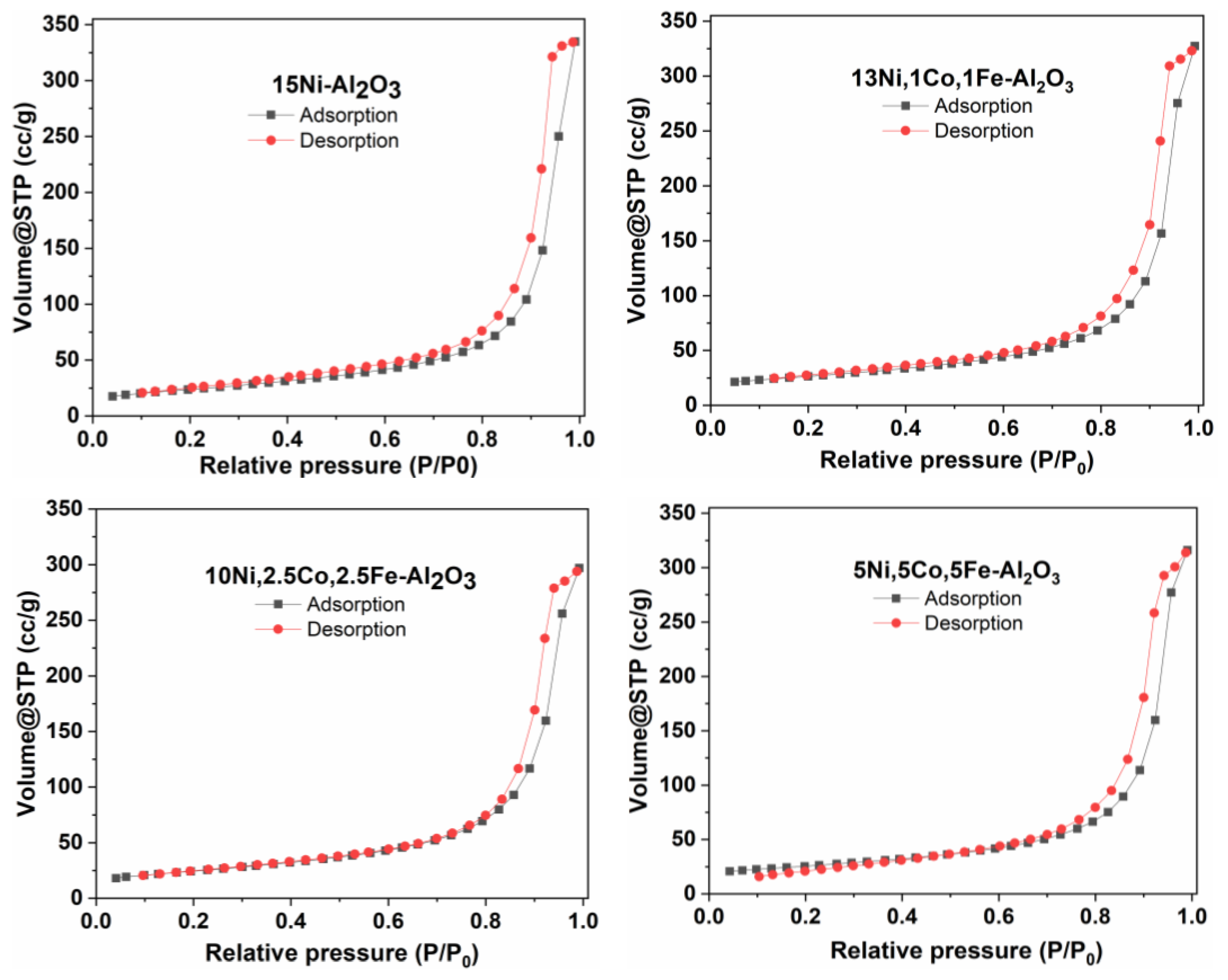

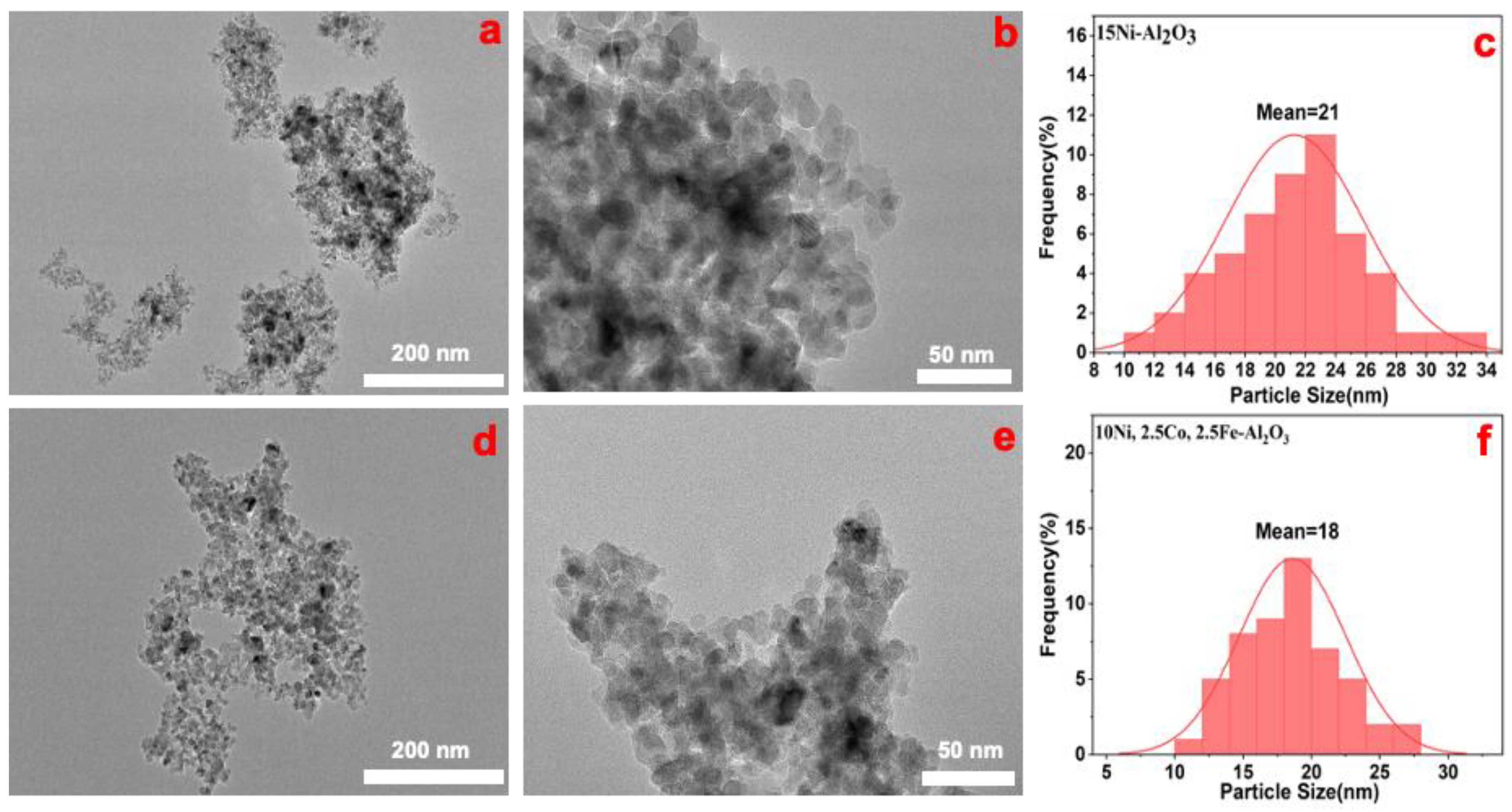
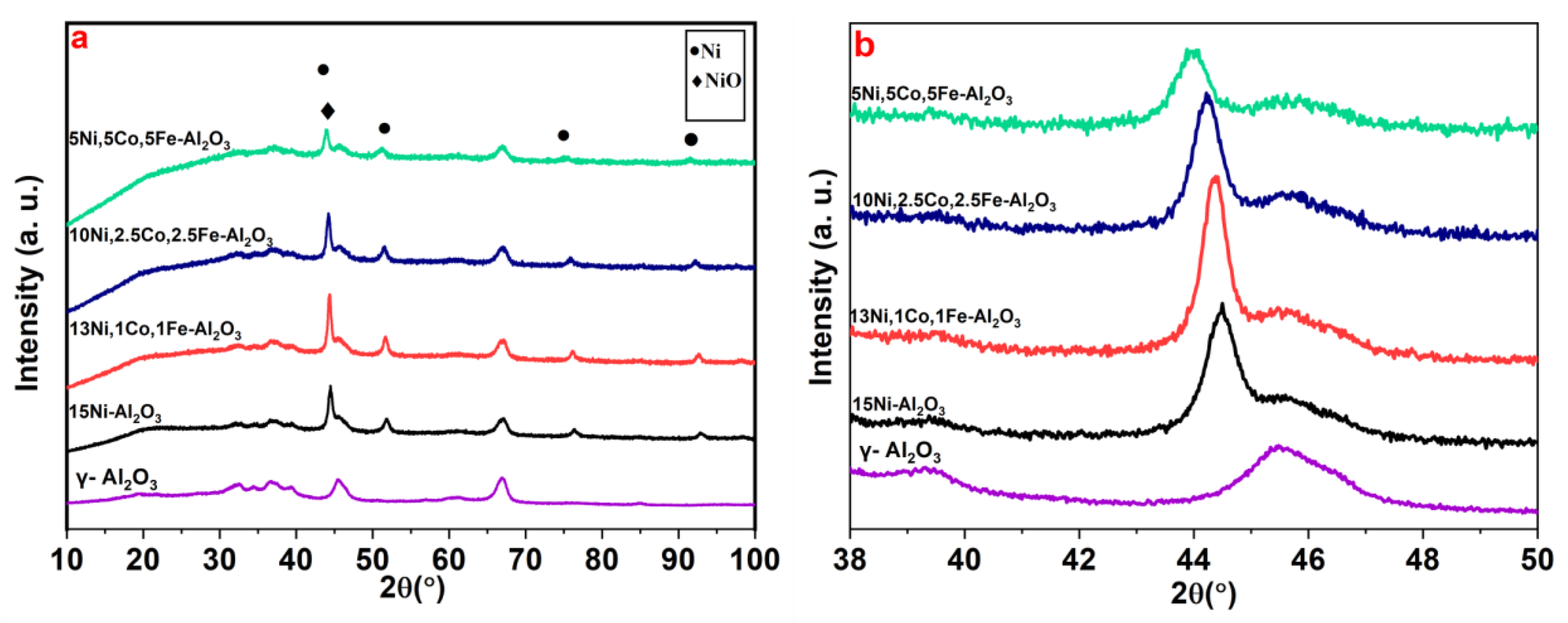
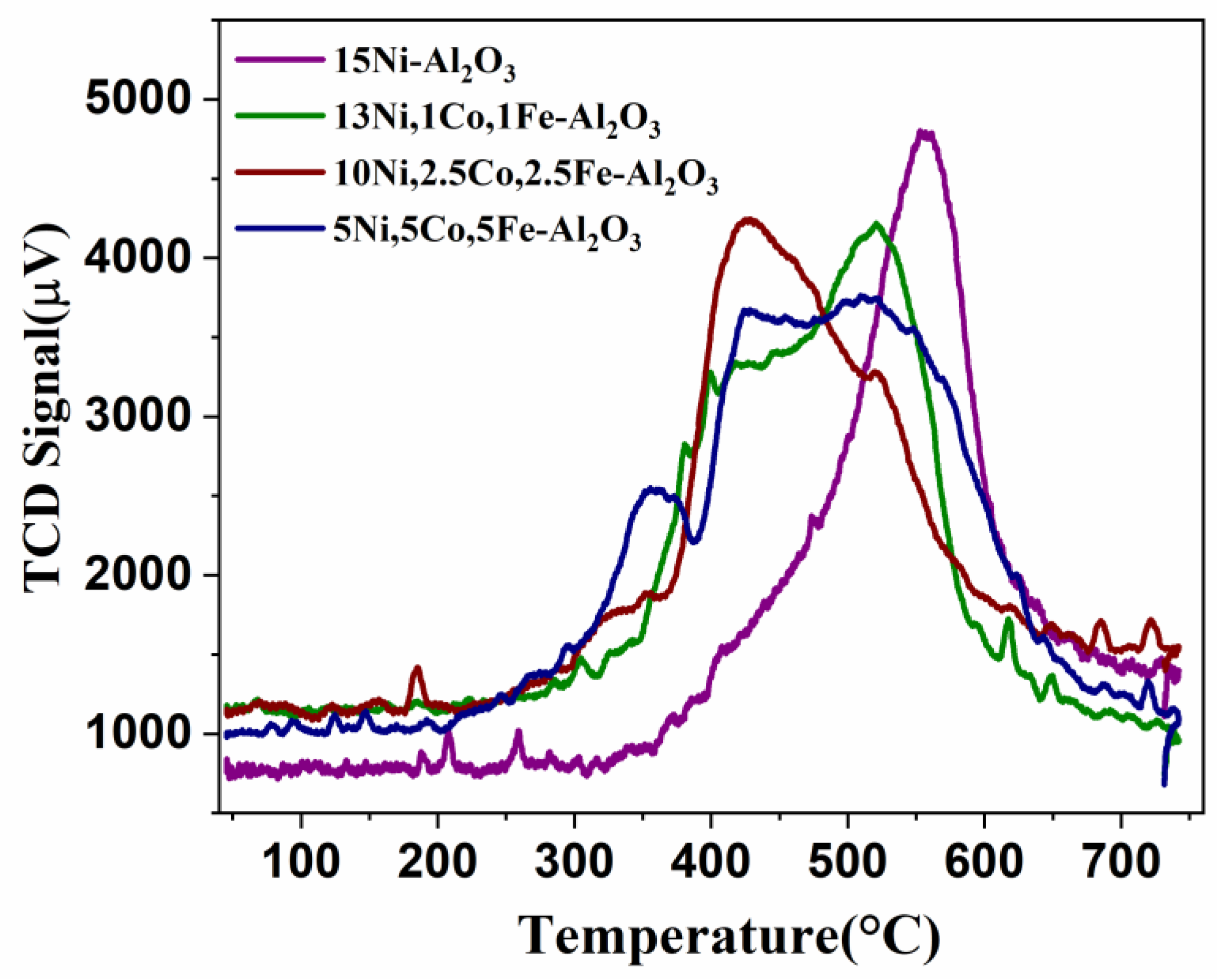

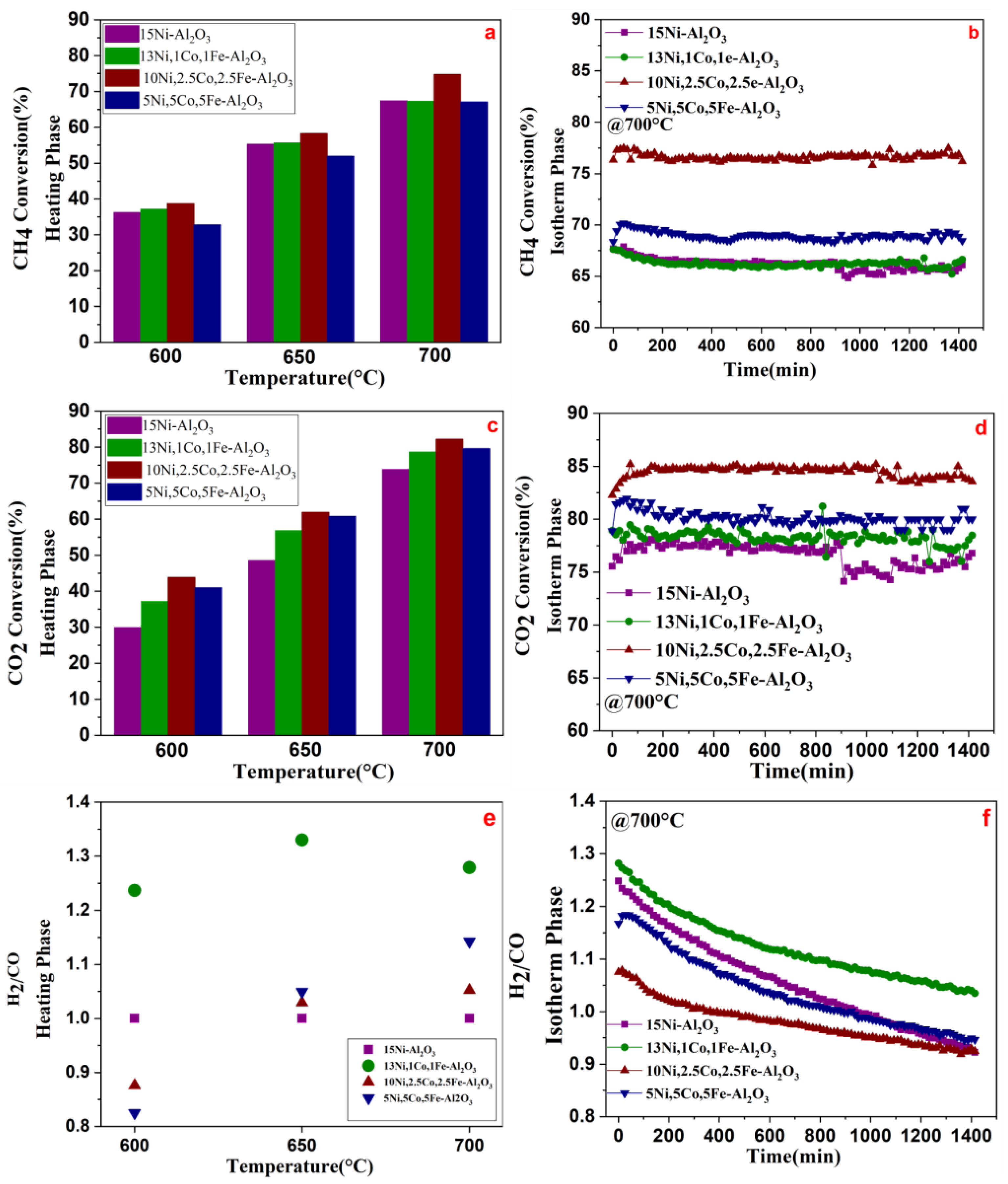
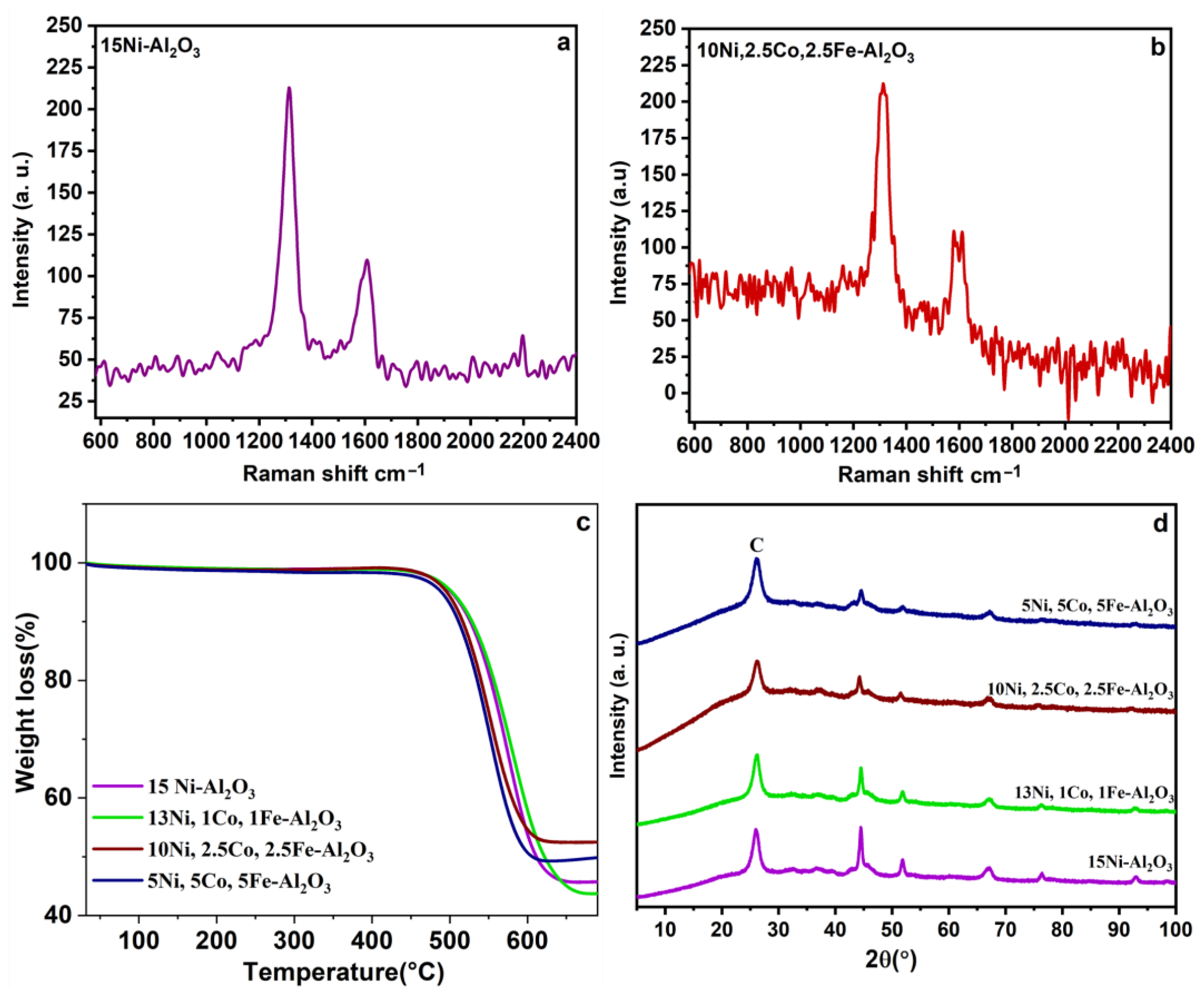
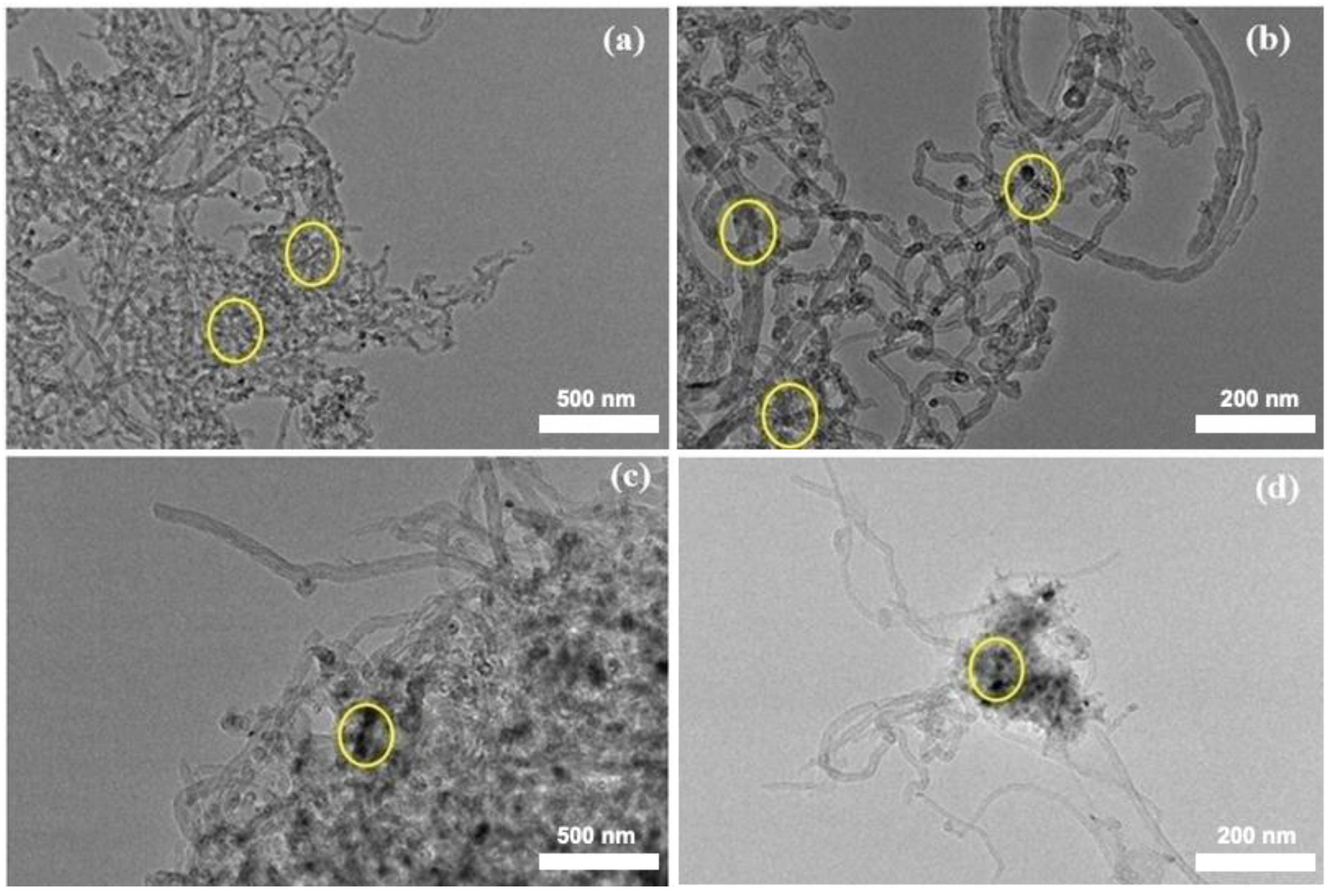
| Name of Reaction | Type of Reaction | ΔH298K (kJ/mol) at p = 1 atm | H2/CO Ratio |
|---|---|---|---|
| SRM | CH4 + H2O → CO + 3H2 | +206 | 3 |
| POM | CH4 + 1/2O2 → 2H2 + CO | −36 | 2 |
| DRM | CH4 + CO2 → 2CO + 2H2 | +247 | 1 |
| ATR | CH4 + 1/2O2 → 2H2 + CO CH4 + H2O → CO + 3H2 | −36 +206 | 2–3 |
| Sample | BET Surface Area, m2/g | Total Pore Volume, cc/g | Pore Size, nm |
|---|---|---|---|
| γ-Al2O3 | 102 | 0.17 | 6.8 |
| 15Ni-Al2O3 | 85 | 0.39 | 18.2 |
| 13Ni, 1Co, 1Fe-Al2O3 | 92 | 0.43 | 18.6 |
| 10Ni, 2.5Co, 2.5Fe-Al2O3 | 87 | 0.40 | 18.1 |
| 5Ni, 5Co, 5Fe-Al2O3 | 88 | 0.43 | 19.7 |
Disclaimer/Publisher’s Note: The statements, opinions and data contained in all publications are solely those of the individual author(s) and contributor(s) and not of MDPI and/or the editor(s). MDPI and/or the editor(s) disclaim responsibility for any injury to people or property resulting from any ideas, methods, instructions or products referred to in the content. |
© 2025 by the authors. Licensee MDPI, Basel, Switzerland. This article is an open access article distributed under the terms and conditions of the Creative Commons Attribution (CC BY) license (https://creativecommons.org/licenses/by/4.0/).
Share and Cite
Khoshroo, G.; Efremova, A.; Basheer, H.S.; Szenti, I.; Shirzadi Ahou Dashti, M.; Szamosvölgyi, Á.; Erdőhelyi, A.; Sápi, A.; Kukovecz, Á.; Kónya, Z. Design and Optimization of Trimetallic NiCoFe Catalysts for Efficient Dry Reforming of Methane. Catalysts 2025, 15, 797. https://doi.org/10.3390/catal15080797
Khoshroo G, Efremova A, Basheer HS, Szenti I, Shirzadi Ahou Dashti M, Szamosvölgyi Á, Erdőhelyi A, Sápi A, Kukovecz Á, Kónya Z. Design and Optimization of Trimetallic NiCoFe Catalysts for Efficient Dry Reforming of Methane. Catalysts. 2025; 15(8):797. https://doi.org/10.3390/catal15080797
Chicago/Turabian StyleKhoshroo, Ghazaleh, Anastasiia Efremova, Haythem S. Basheer, Imre Szenti, Masoud Shirzadi Ahou Dashti, Ákos Szamosvölgyi, András Erdőhelyi, András Sápi, Ákos Kukovecz, and Zoltán Kónya. 2025. "Design and Optimization of Trimetallic NiCoFe Catalysts for Efficient Dry Reforming of Methane" Catalysts 15, no. 8: 797. https://doi.org/10.3390/catal15080797
APA StyleKhoshroo, G., Efremova, A., Basheer, H. S., Szenti, I., Shirzadi Ahou Dashti, M., Szamosvölgyi, Á., Erdőhelyi, A., Sápi, A., Kukovecz, Á., & Kónya, Z. (2025). Design and Optimization of Trimetallic NiCoFe Catalysts for Efficient Dry Reforming of Methane. Catalysts, 15(8), 797. https://doi.org/10.3390/catal15080797










